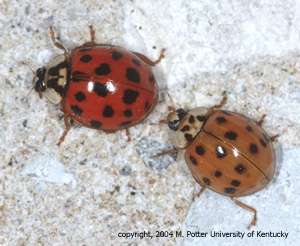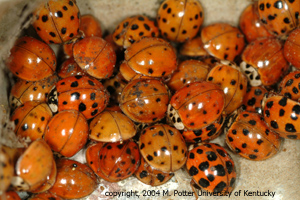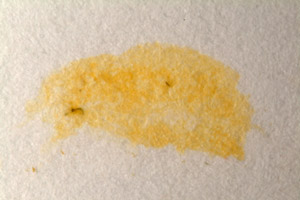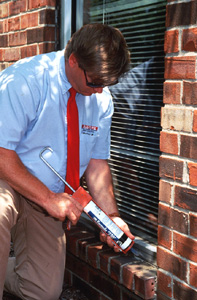Asian Lady Beetle Infestation of Structures
ENTFACT-416: Asian Lady Beetle Infestation of Structures | Download PDF
by Michael F. Potter, Ric Bessin, and Lee Townsend, Extension Entomologists
University of Kentucky College of Agriculture
Large numbers of lady beetles (ladybugs) infesting homes and buildings in the United States were first reported in the early 1990s. Ladybugs normally are considered beneficial since they live outdoors and feed on plant pests.

Asian lady beetles vary in color. Note the whitish area with M-shaped marking behind the head.
One species of lady beetle, Harmonia axyridis, can be a nuisance however, when they fly to buildings in search of overwintering sites and end up indoors. Once inside they crawl about on windows, walls, attics, etc., often emitting a noxious odor and yellowish staining fluid before dying.
In many areas of the U.S., these autumn invasions are such a nuisance that they affect quality of life.
WHERE DID THEY COME FROM?
The Asian Lady Beetle, Harmonia axyridis (Pallas), is relatively new to this country. The beetle is native to Asia (e.g., China, Russia, Korea, Japan), where it dwells in trees and fields, preying on aphids and scale insects. The first field populations in the United States were found in Louisiana in 1988. Since then the beetle has expanded its range to include much of the U.S. and parts of Canada. Earliest records in Kentucky date back to a few specimens collected in Hickman County in 1992.
During the 1960s to 1990s, the U.S. Department of Agriculture attempted to establish the Asian lady beetle to control agricultural pests, especially of pecans and apples. Large numbers of the beetles were released in several states including Georgia, South Carolina, Louisiana, Mississippi, California, Washington, Pennsylvania, Connecticut and Maryland. No such releases were ever attempted in Kentucky, and their occurrence here is probably due to northward migration from other southern states. Some scientists believe that current infestations in the U.S. originated not from these intentional releases, but from beetles accidentally transported into New Orleans on a freighter from Japan.
DESCRIPTION AND HABITS
Adult Asian lady beetles are oval, convex, and about 1/4-inch long. Their color can vary widely from tan to orange to red. They often have several black spots on the wing covers, although on some beetles the spots may be indistinct or entirely absent. Multi-spotted individuals tend to be females while those with few or no spots tend to be males. Most beetles have a small, dark "M" or "W"-shaped marking on the whitish area behind the head.
Eggs are yellow, oval, and typically are laid in clusters on the undersides of leaves. The immatures (larvae) are often orange and black and shaped somewhat like tiny alligators. Larvae complete their development on plants where their primary food (aphids) is abundant. The non-mobile cocoon (pupal) stage remains attached to vegetation by its molted skin, but occasionally may be found clinging to exterior walls of buildings. The average time from egg to adult is about one month and there are multiple generations per year. Individual beetles can live up to three years.
At present, Asian lady beetles appear to have few natural enemies. A small percentage of beetles are parasitized by tiny wasps and flies, while up to 80% are infected by a fungus in central Kentucky, which is only occasionally lethal. As a defense against predators, the beetles secrete a foul smelling yellowish fluid from their leg joints when disturbed. Some mortality occurs at sub-freezing temperatures, although survival is enhanced within buildings and other protected locations if adequate moisture or humidity is available.
In its native land, the Asian lady beetle is mainly tree-dwelling, living in forests and orchards. In Japan, it is also abundant in soybean fields. In the U.S., the beetles inhabit ornamental and agricultural crops, including roses, corn, soybeans, alfalfa and tobacco. During spring and summer, the larvae and adults feed mainly on aphids, consuming hundreds per day.
INFESTATION OF BUILDINGS
As autumn approaches, the adult beetles leave their summer feeding sites in yards, fields and forests for protected places to spend the winter. Unfortunately, homes and buildings are one such location. Swarms of lady beetles typically fly to buildings in September though November depending on locale and weather conditions. In Kentucky, most migration to buildings occurs in October. Beetle flights are heaviest on sunny days following a period of cooler weather, when temperatures return to at least the mid-60s. Consequently, most flight activity occurs in the afternoon and may vary in intensity from one day to the next.


Lady beetles are attracted to sides of buildings receiving afternoon sun.
Contrasting light-dark features are especially attractive.
Studies have shown that Asian lady beetles are attracted to illuminated surfaces. They tend to congregate on the sunnier, southwest sides of buildings illuminated by afternoon sun. Homes or buildings shaded from afternoon sun are less likely to attract beetles. House color or type of construction (concrete, brick, wood/vinyl siding) is less of a factor for attraction than surface contrast.
Contrasting light-dark features tend to attract the beetles -- dark shutters on a light background, light shutters on a dark background, windows edged with light-colored trim, gutters and downspouts on contrasting siding, etc. Dwellings near woods or fields are especially prone to infestation, although those in other locations can be infested as well.

Asian Lady Beetle Congregation
Once the beetles alight on buildings, they seek out crevices and protected places to spend the winter. They often congregate in attics, wall cavities, and other protected locations.
Typical locations include cracks around window and doorframes, behind fascia boards and exterior siding, and within soffits, attics, and wall voids. Structures in poor repair with many cracks and openings are most vulnerable to infestation.
As temperatures warm in late winter/early spring, the beetles once again become active. This usually occurs first on the sunnier, southwest side of the building. As awakening beetles attempt to escape to the outdoors, some inadvertently wander inward, emerging from behind baseboards, walls, attics, suspended ceilings, etc. Since lady beetles are attracted to light, they are often seen around windows and light fixtures.
IMPACT ON HUMANS
Asian lady beetles generally do not injure humans and are mainly a nuisance. Unlike some household pests (e.g., fleas and cockroaches), they do not reproduce indoors -- those appearing in late winter/early spring are the same individuals that entered the previous fall. Lady beetles do not attack wood, food or clothing. Nonetheless, some householders detest finding any insects indoors, and hygienic establishments such as hospitals have zero tolerance for contaminants of any kind.

Asian Lady Beetle Stain
Besides being a nuisance, the beetles emit an acrid odor and can stain surfaces with their yellowish secretions when disturbed (volatile compounds used in defense against bird and other vertebrate predators).
Although Asian lady beetles do not transmit diseases per se, recent studies suggest that infestations can cause allergies in some individuals, ranging from eye irritation to asthma.
People should avoid touching their eyes after handling the beetles, and should consult a physician if they suspect they are having an allergic reaction. When large numbers of beetles are flying in the fall, they often land on clothing and occasionally will bite or 'pinch' if in contact with skin. In nature, lady beetles eat other insects and have chewing mouthparts. The bite feels like a pinprick and is seldom serious.
Asian lady beetles are also becoming a concern of the wine industry. Due to their noxious odor, even small numbers of beetles inadvertently processed along with grapes can taint the flavor of wine.
LADY BEETLE MANAGEMENT
People's reaction to lady beetles varies widely from tolerance to revulsion. The following management tips are provided when the beetles become a serious nuisance within a dwelling.
Vacuuming
Once the beetles are indoors, the easiest way to remove them is with a vacuum cleaner. If you later wish to release the beetles outdoors, place a handkerchief between the vacuum hose and the dust collection bag to act as a trap. A broom can also be used, but is more likely to result in staining when beetles emit their yellowish defensive secretion.
Sealing Entry Points

Sealing Entry Points
Sealing cracks and openings is the most permanent way of preventing lady beetles from entering buildings. The time to do this is in late spring or summer, before the adults begin flying to buildings in search of overwintering sites. Cracks should be sealed around windows, doors, soffits, fascia boards, utility pipes and wires, etc. with caulk or other suitable sealant.
Larger holes can be plugged with cement, urethane foam or copper mesh. Repair damaged window screens and install screening behind attic vents, which are common entry points for the beetles. Install tight-fitting door sweeps or thresholds at the base of all exterior entry doors. Gaps of 1/8" or less will permit entry of lady beetles and other insects. Gaps under sliding glass doors can be sealed with foam weather stripping. These practices will also help prevent entry of flies, wasps, crickets, spiders and other pests. Some householders may find it more practical to hire a pest control firm, building contractor or painter to perform these services (For more on this topic see University of Kentucky entomology fact sheet, How to Pest-Proof Your Home).
INSECTICIDES
Indoor Treatment - Insecticide foggers, "bug bombs" or sprays are generally not recommended for eliminating beetles indoors. Insecticides applied indoors for lady beetles tend to be ineffective and may stain or leave unwanted residues on walls, countertops and other surfaces. A vacuum is more sanitary and effective. Attempting to kill beetles hibernating in wall cavities and other protected locations is seldom effective. A better approach is to take preventive measures to reduce beetle entry in subsequent years.
Exterior Barrier Treatment - While sealing cracks and openings is a more permanent way to limit beetle entry, the approach is time-consuming and sometimes impractical. There can be countless cracks associated with eaves, siding, vents, etc. where insects can enter. On multi-story buildings, sealing becomes even more difficult.

Exterior Barrier Treatment
If lady beetles are a perennial problem, owners may want to hire a professional pest control firm. Many companies apply insecticides to building exteriors in the fall, which helps prevent pest entry. Fast-acting residual insecticides can be sprayed in a targeted band around windows, doors, eaves, soffits, attic vents, and other likely points of entry.
Some of the more effective insecticides used by professionals include Demand (lambda cyhalothrin), Suspend (deltamethrin), Talstar (bifenthrin) and Tempo (cyfluthrin). Effective over-the-counter versions of these products include Spectracide Triazicide, Bayer Advanced Powerforce Multi-Insect Killer, and Ortho Home Defense Max. Purchasing these products in concentrated (dilutable) form will allow larger volumes of material to be applied with a pump-up or hose-end sprayer.
To be effective, barrier treatments should be applied before the beetles enter buildings to overwinter. In Kentucky, the proper timing for such treatments is typically late-September to early October although this will vary with seasonal conditions. During late winter or early spring, barrier treatments are ineffective since the beetles gained entry the previous autumn.
Other Approaches
Other approaches have been suggested to alleviate problems with Asian lady beetles. Ladybug "houses" sold in garden supply catalogs will have no effect in keeping the beetles out of your home. Light traps can be useful for capturing flies and lady beetles in dark confined spaces such as attics, but will capture relatively few beetles entering living spaces in the fall or emerging from hidden locations the following spring.
Unfortunately, there is no "quick fix" or easy answer to annual lady beetle invasions. Vacuuming, pest proofing and properly timed exterior insecticide treatments can provide relief but will not prevent entry of every single beetle.
Issued: 10/93
Revised: 6/05
CAUTION! Pesticide recommendations in this publication are registered for use in Kentucky, USA ONLY! The use of some products may not be legal in your state or country. Please check with your local county agent or regulatory official before using any pesticide mentioned in this publication.
Of course, ALWAYS READ AND FOLLOW LABEL DIRECTIONS FOR SAFE USE OF ANY PESTICIDE!
Images: M. Potter, University of Kentucky Entomology.
